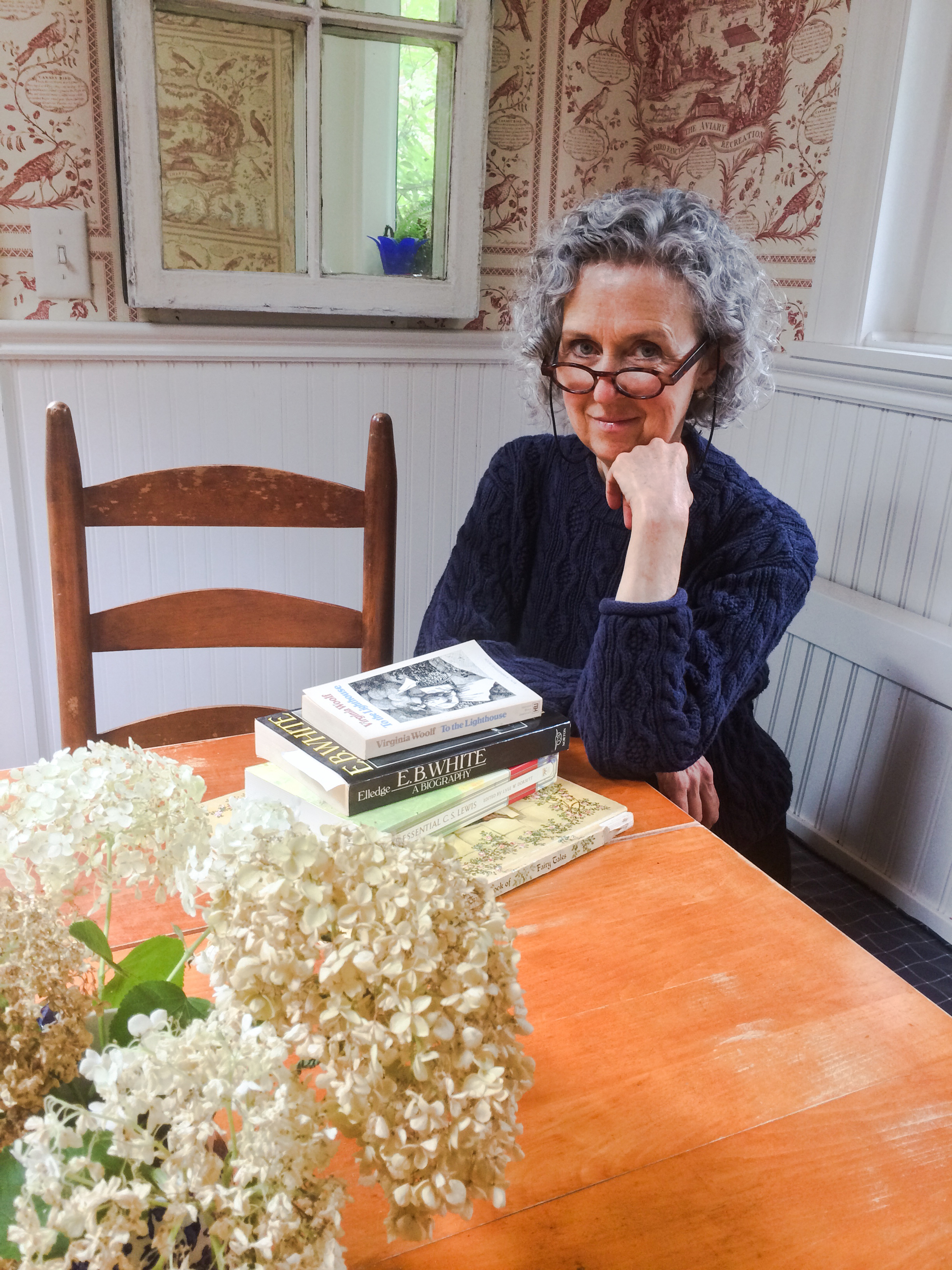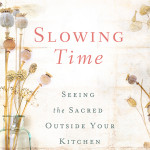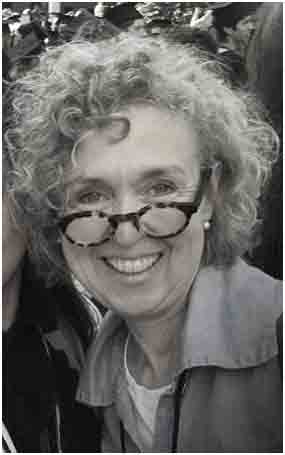Editor’s Note: Welcome to the newest installment of “Writing the Book,” an occasional Storyboard feature in which journalists turned authors discuss the challenges of creating their work. In this essay, freelancer and 2013 Nieman affiliate Barbara Mahany explores how she approached writing about the sometimes uncomfortable issue of spirituality in her upcoming book, “Slowing Time: Seeing the Sacred Outside Your Kitchen Door,” which Publishers Weekly recently named one of the top 10 religion books of fall 2014. You can find the archive of “Writing the Book” here.

Barbara Mahany
I’ve written about my mother’s cancer. And the string bean of an unborn baby who slipped through my fingers in the dark of the hollowest night, amid clots of blood and a wail of primal grief.
I’ve written about the abyss of the hour when I paced an emergency room, waiting to hear if my older son’s spinal cord had been severed when he flew from his bike to a trail in the woods. I even once dared to write — in the pages of the Chicago Tribune, my hometown newspaper — how I became anorexic my senior year of high school, and, in the flash of a few short spring months, plunged from glory to shame in my infamy as the homecoming queen who had to be hospitalized after dropping 50 pounds.
But saying out loud that I look for and find God nearly everywhere I wander? That scared me.
Especially among my fellow journalists, for whom skepticism is religion. Pulling back Oz’s curtain, taking down the too-powerful, those are the anointed missions. To stand before an imagined newsroom and say I bow to the Almighty source of all blessing, I believe in the Unknowable, the Invisible, a force I know to be tender and endless and ever in reach, a magnificence that animates my every hour, that is to stand before the firing line. That is to expose yourself, I feared, as unfit for Fourth Estate duty.
But I did it. Led by a deep, still voice.
Now, it’s all bound in a book, called Slowing Time: Seeing the Sacred Outside Your Kitchen Door (Abingdon Press, 2014). And, as of Oct 7, you’ll find it in bookstores, on Amazon, even on the shelf of my town’s library.
The burning question for a journalist who’d dare to chart the spiritual landscape is how, using the tools of the craft, do you toughen the fibers, sharpen the edges, of a subject that, by definition, is formless? How do you put hard-chiseled words to believing, indeterminate act that it is?
For me, it boils down to three non-negotiables: Pay exquisite attention, even when it’s your soul you’re sliding under the examiner’s lens; root yourself in the earthly while soaring toward the heavenly; and don’t flinch. Your edge comes from your capacity to pull back the veil where others dare not.
Paying Attention
It struck me recently that my paying-attention curriculum, the part that came from syllabus as much as natural-born curiosity, began in the halls of a college of nursing, where in shiny-linoleum-tiled classrooms, in the fall of 1976, a whole lot of us — sophomore nursing students on a four-year track — began to learn to see the world through a nurse’s dare-not-miss-a-detail eyes.
My very first assignment, once a white nurse’s cap had been bobby-pinned to my run-away curls, was to bathe a woman who was dying of a cancer. I was taught, straight off, to look deep into her eyes, to read the muscles flinching on her face, to hear the cracking of her words as she tried to tell me how warm she liked her bath, and which limb hurt too much for me to lift it.
And on and on, the learning went — as I became a pediatric oncology nurse at Chicago’s Children’s Memorial Hospital, and watched the waning light in the eyes of a 15-year-old boy at the hour of his death. As I gauged the depth of blue circling the lips of 6-year-old girl with cystic fibrosis. As I buried the sobs of a wailing father against my shoulder, as he absorbed the diminuendo of his 12-year-old daughter’s final breaths.
At the precipice of life and death, I learned to live a life of close examination. And when I made the leap from nursing to newsroom, a narrative twist brought on by the sudden death of my father, and an off-handed comment after his funeral that I ought to try my hand at journalism, I only broadened my lens. Paid keener attention to the singular detail that revealed the deeper story.
Root yourself in the earthly.
Even if I’ve never broadcast the holiness that informs my every day, it’s always been there. It was front and center, back in 1985, when I criss-crossed the country, documenting the faces and forms of hunger in America, for a 10-part series unspooled in the Tribune. It was a pilgrimage that put flesh to my own personal gospel: One that drove me to see the face of God in everyone whose path I happened to tread, everyone whose story spilled into my notebooks. From ramshackle cabins in Greenwood, Mississippi, to urine-stenched stairwells in Chicago’s Cabrini-Green, high-rise housing hell.
I never set out to be a religion writer, though when the slot opened once at the Tribune, I gave it a moment’s consideration. Nor did I ever set out to expose the whispers and truths of my soul. All I wanted was to hold up to the light the stories of everyday sinners and saints who so richly animate the grid, urban or rural or spaces between. It was in the backwash of the forgotten, the pushed aside, the indomitable that I noticed the glimmering shards.
In my own way, always drifting toward stories that fell in the crosshairs of human struggle or anguish and rose in crescendo toward triumph or wisdom gained, I was gathering notes on the human spirit, and never surprised when I felt the hand of God — like a thud to the heart, or, more often, a tickle at the back of my neck.
There’s an ancient Hebrew text, one with echoes of Plato’s “Allegory of the Cave,” that teaches us that while we can’t see God, we can see God’s shadows. The more etched the shadows, the more we know God, according to the teaching. It’s wisdom that drives me to tether my prose in the concrete, to allow the metaphor to spring from the particular, to capture a glimpse of the Holy from the depths of ordinary.
Don’t flinch.
Back in 2006, my then 13-year-old, who’d scored enough in bar mitzvah gifts to cash in on a refurbished MacBookPro, bequeathed his old laptop to me. As part of the deal, he built me a website one December night when the winds whistled in through the cracks in the door. He told me I could handle a blog. I shivered.
Then I started to type. Called it “Pull Up a Chair.” Set out to write about the heart and soul of the home front.
Each weekday morning for a year, I rose before dawn, poured a tall mug of caffeine, and I wrote. Exercised narrative muscles I’d never known were there. Connected dots in the course of free-flowing sentences. Sometimes felt the particular buzz that tells you you’ve tapped just the right vein. The one, in my case, that flowed from my heart to my soul. I’ve been writing that blog ever since. Nearly eight years of accumulated essays.
By day, I forged on with the daily grind of newspapering. But what happened at dawn – the writing that drew me into places I’d never explored aloud – it freed a particular voice. What had been un-utterable became a tremulous whisper, and, in time, a brave clear call.
Along the way, I’ve endured what might be the hardest lesson: The one where I find myself plumbing depths that are truer than true, though I’d never quite put them to words. As in: “I seem to hum most contentedly when my canvas has room for the paint dabs of God. When I hear the wind rustling through pines, when I take in the scarlet flash in the bushes, when I trace the shift in the shadows through the long afternoon, that’s when I feel the great hand of the Divine slipping round mine, giving a squeeze. That’s when I know I am not deeply alone. But, rather, more connected than in a very long time.”
Or: Writing of the sleepless night when, in desperation, I reached for a rosary I’d not fingered in years. “It’s the [rosary] I squeezed till my fingers turned white when they threaded the wire into the heart of the man who I love, the man who I married. And when they dug out the cancer from the breast of my mother. And that I would have grabbed, had I known, on the crisp autumn night when the ambulance carried me and my firstborn through the streets of the city, his head and his neck taped to a stretcher. I prayed without beads that night, I prayed with the nubs of my cold, clammy fingers.”
Call me crazy — or oddly courageous — to invite readers under my bedsheets, where I finger the rosary. To whisper aloud the words of my prayer, not cloaked in cotton-mouthed vagaries, but laid bare in the most intimate script, the one that unfurls from my heart to the heavens.
Instead of playing it safe, instead of turning and running, I plunge forward. I follow the truth. I say it out loud. And then I hit “publish.” Often, I find myself queasy. Call a dear friend. I rant, and I fret. Consider deleting the post. Then the emails come in, the ones that tell me I’ve captured a something someone never quite noticed, something that gave them goosebumps. And therein, I discover communion, in its deepest iteration. That’s how you learn not to flinch.
The story of how my book came together — how hundreds of pages were sorted and sifted and whittled and culled, how words written in silence at my old kitchen table would emerge to be passed from friend to friend — is, like most things spiritual, an amalgam of the mystical and the prosaic.
 It all traces back to books I spied on the desk of the Cambridge professor who would become our landlord during our Nieman year. I knew, once I saw the stacks of poetry and divinity titles, that his book-lined aerie, the top floor of a triple-decker just off Harvard Square, was the one we needed to rent. What I didn’t know is that the gentle-souled professor would soon introduce me to a Boston book editor he termed, “the best of the best.” Nor that I would fly home to Chicago at the end of that Nieman year with a contract and an end-of-summer deadline for a book I’d loosely conceived of as a Book of Common Prayer, believing it’s the quotidian rhythms that hold the deepest sparks of the Divine, and it’s in the rush and the roar of the modern-day domestic melee – held up to the light — that I find improbable holiness.
It all traces back to books I spied on the desk of the Cambridge professor who would become our landlord during our Nieman year. I knew, once I saw the stacks of poetry and divinity titles, that his book-lined aerie, the top floor of a triple-decker just off Harvard Square, was the one we needed to rent. What I didn’t know is that the gentle-souled professor would soon introduce me to a Boston book editor he termed, “the best of the best.” Nor that I would fly home to Chicago at the end of that Nieman year with a contract and an end-of-summer deadline for a book I’d loosely conceived of as a Book of Common Prayer, believing it’s the quotidian rhythms that hold the deepest sparks of the Divine, and it’s in the rush and the roar of the modern-day domestic melee – held up to the light — that I find improbable holiness.
And so, what had been occasional dabblings into the sacred realm — written over seven years, refined over one summer — became a tightly woven tapestry that now, as I read from beginning to end, feels something like a banner. Or maybe a prayer shawl in which I quietly, devoutly, wrap myself.
I’m braced – I hope – for the cynicism, or maybe worse, sheer dismissal. A dear friend, one whose book spent the summer on the New York Times best-seller list, gave me what amounts to a lifeline: “The real reviews,” she said, “come in handwriting and human voices.” Already, those voices have begun to trickle in, to tell me they’re staining the pages with coffee rings as they read and ponder and read some more. To tell me they’re giving the book to their dearest circle of friends. To tell me they’ve underlined and scribbled in the margins. To tell me one particular essay carried one reader through the week-long dying of her mother.
I’ve found my holiness slow and steady. It crept up unawares, almost. I never expected that I’d write a prayerful book, with my name on the cover, and my heart and my soul bared across its pages.
But nothing has ever felt quite so right. Nothing so quietly sacred.
Barbara Mahany is an author and freelance journalist in Chicago, who writes these days about stumbling on the sacred amid the cacophony of the modern-day domestic melee. She was a reporter and feature writer at the Chicago Tribune for nearly 30 years, and before that a pediatric oncology nurse. She tagged along on the 2012-13 Nieman fellowship of her husband, Blair Kamin, the Tribune’s longtime architecture critic.


